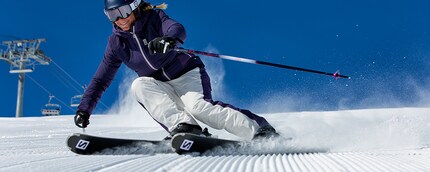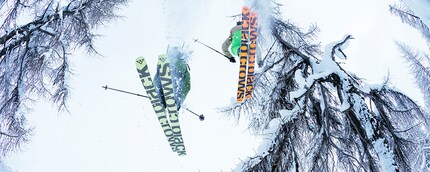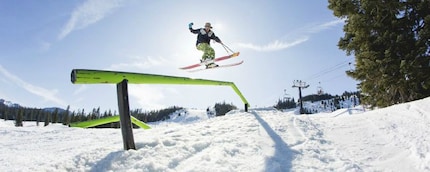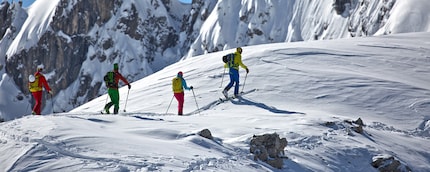
A little guide to skiing: find the right boards for your runs!
With a multitude of technologies and a huge choice of models on the market, finding the right skis isn't always easy. We can advise and help you find the right skis for your preferred terrain, your experience and your style of skiing, to ensure you get the most out of winter. Whether you're looking for all-mountain, freeride, freestyle or touring skis, you're sure to find what you're looking for!

All-Mountain
All-Mountain skis remain the preferred type of ski, as they offer good sensations both on and off the slopes. Under the binding, the skis are generally quite wide, which offers good buoyancy off-piste without taking you too long to change edges on the slopes. All-mountail skis are lightweight and often feature stabilising elements that give them a calm demeanour on and off the slopes. The sidecut (radius) of these skis is extremely long and they are therefore not suited to an aggressive style.
Atomic's Cloud Nine is one of the best-selling women's skis in the world: it provides better turn entry, more precise and effortless turns. Nordica's GT 76 Ti (men's) has a slightly oversized tip to work perfectly on groomed pistes as well as off-piste. Salomon's M X-Drive 8.3 (men's) offers better edge grip thanks to the reinforced carbon frame.
Overview:
- Skate width: 72-85mm
- Rayon: 17-22m
- Dynamics on the slopes
- Sufficient flotation in powder
- Powerful curves and stability for medium to high speed

Freeride
Freeride skis, particularly wide and long with a hybrid profile score especially well off-piste and especially in fresh snow. The directional shape accentuates buoyancy and makes the freestyle ski the ideal partner, even on the slopes. You can choose between an extremely wide ski for powder - like the 120mm K2 Shreditor (men) - or a slightly thinner freeride ski. Atomic's Backland (men's/women's), for example, or Head's Big Joy (women's), are suitable for fresh snow and powder, but offer better performance on the slopes and when climbing with skins than dedicated powder skis.
Overview:
- Skate width: from 95mm
- Generous sidecut
- Great buoyancy in powder
- Directional¹ with taper²
- Binding setback
- Reduced dynamics on hard runs due to width

Freestyle
Freestyle and jib skis have been popular and exciting new generations for many years. Bindings mounted in the centre of a double-tip ski have revolutionised the sport: these freestyle skis can be controlled perfectly both forwards and backwards and, thanks to their wider construction, they offer greater stability for big jumps. The length of freestyle skis generally corresponds to the height of the skier. The symmetry of the tip and tail allow the centre of gravity to be concentrated in the middle of the ski.
The Linke (men's) ski by professional freestyler Tom Wallisch is dedicated to younger, or lighter, skiers. Völkl's Step (men's) is specially optimised for park and pipe. Salomon has developed a top-of-the-range, durable freestyle ski that offers a pleasant gliding sensation and is forgiving of mistakes when landing: the N NFX (men).
Overview:
- Thin skate up to 95mm
- Short radius for tight, fast turns
- Thin tip and tail
- Twin tip
- Directional Twin for occasional off-piste outings

Touring skis
Touring skis are special skis that are used for touring. It is often shorter, wider and more flexible than a traditional alpine ski to facilitate descents in powder and wet snow. It's also lighter than a piste ski, which saves you power when climbing. However, the ski loses comfort on the slopes, because it's not as hard and direct as an alpine ski. But this becomes an advantage again in fresh snow.
For touring skis, there is a difference between 3 types:
- Mounted-oriented touring skis, such as Atomic's lightweight Backland (men's) are ideal for regular, longer tours with a vertical drop of 1000m and more (up to 83mm width under the binding).
- The versatile touring ski, like the Talkback 88 (women's) from K2 is ideal for anyone who likes to savour the uphill as well as the downhill and wants to be able to tackle everything with just one ski (84 to 89mm width under the binding).
- The downhill-oriented touring ski is dedicated to short tours with a freeride downhill tendency (90mm and more width under the binding). The Wayback 96 from K2 (men), for example, is 96mm wide and therefore has great buoyancy in powder. Compared to other models it is also the heaviest model.
See all touring skis // See touring accessories
Choosing your size
Once you know which ski is right for you, we have a few more tips for choosing the right ski size. As a general rule, we say that the ski should arrive between the chin and the top of the head. If you're an advanced and experienced skier, then you can also choose skis that are a little bigger than you are. This rule also applies to freeride skis. Shorter skis turn more easily, but don't glide as smoothly as longer models. Carving skis can be shorter than All Mountain or Big Mountain skis.
Shorter skis are dedicated to:
- beginners or average skiers
- tight and fast curves
- groomed runs
A longer ski is advised when you:
- is an experienced skier.
- wants to go fast and when you have a slightly more aggressive style.
- prefers to go off-piste
- would like to have double tip or rocker skis
Aside from skis, you'll also find a great selection of accessories with us: from masks and helmets to protectors and bags to ski poles, boots and bindings, you'll find everything you need for the perfect ski equipment! See the entire ski range
¹Directional: this shape is ideal for sliding forward. The tip is longer than the tail and the flex is often different. Thanks to this construction, the ski has better manoeuvrability and is more stable. With directional skis, you're perfectly equipped for all terrain outside the park. The directional shape is found in both All Mountain skis and freeride skis.
²The widest point of contact allowing itself to be moved inwards is called taper. Tip and tail become wider and the effective edge length changes. The further inwards the contact points are, the more the effectiveness of the edge decreases. Shorter lengths make for smoother turn initiation. On the contrary, longer lengths facilitate longer, more powerful turns.
You may also be interested in this article:
Whether on the sea, on the road or in the glittering powder. I prefer to move sideways on the board. It may sound trite, but for me it is still the best feeling in the world. It's the perfect balance to my job as a product manager in winter, water and fun sports. Shred it!











